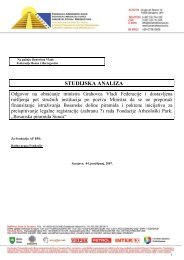The Complete Guide To Mysterious Beings - Galaksija
The Complete Guide To Mysterious Beings - Galaksija
The Complete Guide To Mysterious Beings - Galaksija
You also want an ePaper? Increase the reach of your titles
YUMPU automatically turns print PDFs into web optimized ePapers that Google loves.
<strong>The</strong> husband of another witness, Hugh Kennedy, described it this way: ”It was a large cat-like<br />
animal, similar to a lynx. It was larger than my blue cattle dog, possibly eighteen to twenty inches<br />
in height, tawny colored, with a long, smooth, cat-like tail. <strong>The</strong> body was long, narrow, and sleek.<br />
”<strong>The</strong> most frightening part was the cat-like head, small pointed ears, and terrific fangs. It hissed like<br />
a cat and used its front paws to keep off the dogs. Unfortunately, by the time the wife had returned<br />
to the house to get a rifle, the animal had vanished. However, it was afraid neither of dogs nor<br />
humans.”<br />
<strong>The</strong> town of Emmaville, Australia, was caught up in a routine monster panic in the early 1960s<br />
when a beast killed seventy sheep, sometimes eating four in one night and leaving nothing but the<br />
hides. Although many people saw the culprit, it was never caught or killed. One witness described<br />
the thing that ran in front of his auto headlights as being about two feet high, with slender back legs,<br />
smallish back paws, a heavy head, a long tail with a blunt end, and irregular, black and white stripes<br />
on both body and tail.<br />
In Furred Animals of Australia, author Ellis Troughton remarked:<br />
Although such an animal has been reported on several occasions, no specimen has ever<br />
reached any museum to verify the occurrence scientifically. <strong>The</strong>re are often simple<br />
explanations for such reports, but the consistency of the accounts suggests the possibility of<br />
the presence of some large carnivorous marsupial of the dasyurid family (which includes the<br />
thylacine).<br />
In future, observers should make every effort to obtain both the skull and complete skin of a<br />
specimen and ensure the preservation by heavy salting before forwarding the remains to the<br />
local museum... <strong>The</strong> failure of observers to obtain any parts of the hide, hair, or skull, casts<br />
much doubt over the reports of such an animal.<br />
<strong>The</strong> thylacine, referred to above, is the Tasmanian tiger, a freakish and elusive beast found on the<br />
island of Tasmania. It has been caught and caged. It looks something like a cross between a mongrel<br />
dog and a hyena, has stripes on its back, and comes equipped with a kangaroo-like pouch in which<br />
it carries its young. Before one of these animals was finally brought to bay, you can imagine the<br />
kind of reaction Tasmanian witnesses got when they reported seeing a giant striped dog carrying its<br />
young in a pouch.<br />
Gippsland, Australia, has produced another Unbelievable. It is a giant earthworm which looks like a<br />
garden hose and grows to as much as ten feet in length. It burrows deep in the earth and is hard to<br />
catch because it can coat itself with a very slippery lubricating fluid. But it has been caught and<br />
studied, as has another monstrous Australian worm known as the Megascolides. In the Bulletin of<br />
the New York Zoological Society (March-April 1938), Charles Barrett announced, ”I have seen<br />
many specimens extending seven feet when extended, and a number about two feet longer. My<br />
record Megascolides was over ten feet.”<br />
If you ever go fishing for a sea serpent you should probably use a Megascolides for bait. <strong>The</strong> trick<br />
to catching one, according to the experts, is to tie it in a knot so it can't burrow into the ground and<br />
get away from you. It can squirt its lubricating fluid a couple of feet, so wear old clothes.<br />
Perhaps giant earthworms may account for some of the grotesque snake stories that have been<br />
produced in nearly every state over the years. Enormous reptiles, sometimes described as being<br />
twenty feet or more in length, are seen with astonishing frequency in the United States but, so far as<br />
science knows, no snakes of such unusual size exist here at all. Minor constrictors such as the king<br />
snake and the black snake are common enough and can grow to six or seven feet in length on a diet<br />
of rodents and smaller snakes. But they avoid men. In fact, contrary to all the Hollywood jungle<br />
movies, even the largest known boa constrictors will not wantonly attack anything they cannot<br />
swallow – which, of course, includes man. In self-defense a boa will wrap itself around a man, bite<br />
him, and hammer at his head with its bony snout, inspiring considerable discomfort. But there is<br />
only one reasonably documented story about a boa attempting to swallow a human being. This is<br />
supposed to have occurred in the jungles of Burma during World War II, when some Japanese










